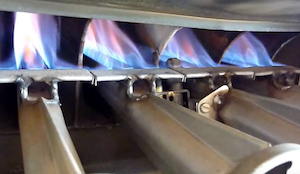Anyone who has ever experienced a cold climate knows how essential a furnace can be. Experiencing a harsh winter without one because yours broke down would not be fun at all. However, an emergency installation may be rushed and end up costing more than one that was planned well in advance. Below are nine signs that it is time to consider replacing your furnace.
1. The Age of Your Heating System
Contents
- 1 1. The Age of Your Heating System
- 2 2. A Rising Heating Bill
- 3 3. Is Your Flame the Correct Color?
- 4 4. Any Strange Noises Your Furnace Is Making
- 5 5. Does Your Furnace Struggle to Stay or Remain On?
- 6 6. Does Your House Have Cold Spots or Ice on the Roof?
- 7 7. Is Your Family Getting Sick More Often Than Normal?
- 8 8. How Is Your Indoor Air Quality?
- 9 9. Have You Needed Multiple Heating Repairs?
On average, a properly maintained furnace lasts anywhere from 12-15 years. Older systems will require regular repair work, and become less efficient even if that work is performed perfectly. If your system is 12 years old or older and frequently requires extra maintenance, it may be a good time to start thinking about replacing it.
Call Today For A Free, In-Home Estimate.
Call (800) 253-9001

2. A Rising Heating Bill
To be sure, there are multiple reasons your bill could be going up. Whether you use gas, propane, or oil, the price fluctuates daily. A particularly cold winter or a drafty house could also drive up your bill. Still, the loss of your furnace’s efficiency could be a major cause of the increased bill. If your furnace is aging and your heating costs are going up, replacement may be your best option.

3. Is Your Flame the Correct Color?
 It is supposed to be bright blue. If it constantly flickers or adopts a yellowish hue, it could be an indication that your furnace is not burning the fuel completely. Alternatively, it could also mean that your system is producing more carbon monoxide than normal. Carbon monoxide is a harmful chemical that you really do not want airborne in your home. Some other indicators of carbon monoxide include:
It is supposed to be bright blue. If it constantly flickers or adopts a yellowish hue, it could be an indication that your furnace is not burning the fuel completely. Alternatively, it could also mean that your system is producing more carbon monoxide than normal. Carbon monoxide is a harmful chemical that you really do not want airborne in your home. Some other indicators of carbon monoxide include:
- Soot streaks around your furnace.
- The lack of a strong upward draft coming out of your chimney.
- Excessive moisture visible on exterior windows and walls.
- A pool of water around the base of your chimney or flue pipe.
- A rusted vent pipe.
If you have any or all of these problems, a carbon monoxide inspection should be performed as early as possible.
4. Any Strange Noises Your Furnace Is Making
Put simply, your furnace should not be making any strange sounds. If you constantly hear rattling, banging, squeaking, popping, or hissing, it is possible that it is time for a new furnace. While your furnace’s blower fan should be on sometimes, furnace replacement may also be necessary if it seems to always be on.
5. Does Your Furnace Struggle to Stay or Remain On?
Older furnace systems have a hard time staying on. It is possible that a simple repair, such as new wiring or thermostat replacement, will fix this problem without replacing the entire furnace. However, continual malfunctioning is a fairly strong indicator that the entire system should be replaced.

6. Does Your House Have Cold Spots or Ice on the Roof?
If there is a room in your house that always feels cold no matter what, it is possible that your furnace is no longer capable of heating it adequately. That would mean that you need to replace your furnace. If ice is beginning to build on your roof, heat may be leaking from the duct work in your attic. There is no easy test to determine if this is the case for your home, so contacting an expert to conduct a thorough inspection is your best bet.
Call Today For A Free, In-Home Estimate.
Call (800) 253-9001

7. Is Your Family Getting Sick More Often Than Normal?
 This can be another indicator of harmful carbon monoxide. The symptoms of exposure to low levels of carbon monoxide include nausea, lightheadedness, headaches, and other flu-like symptoms. Older furnaces may develop cracks that allow the harmful gas to seep into your home, making your family get sick more often than usual. If you think that your furnace may be causing your family to not feel well, the best thing to do is contact a heating expert you trust. They will be able to conduct a complete inspection and provide honest recommendations on what you need to do to keep your family safe.
This can be another indicator of harmful carbon monoxide. The symptoms of exposure to low levels of carbon monoxide include nausea, lightheadedness, headaches, and other flu-like symptoms. Older furnaces may develop cracks that allow the harmful gas to seep into your home, making your family get sick more often than usual. If you think that your furnace may be causing your family to not feel well, the best thing to do is contact a heating expert you trust. They will be able to conduct a complete inspection and provide honest recommendations on what you need to do to keep your family safe.
8. How Is Your Indoor Air Quality?
While modern furnaces offer a fantastic suite of air quality features including humidification options, older models can leave your indoor atmosphere wanting. It could feel stuffy or stale. It may also feel dry, causing your skin to dry out and/or aggravating your sinuses when your nose and throat dry out. Dry air allows dust to accumulate in your home, potentially exasperating allergies during the winter months.
Excessively dry air can also kill any indoor plants you have. You may also experience an increased amount of static electricity shocks and dried out wood flooring, furniture, and musical instruments. The latter even become more challenging to keep in tune. While these things happen in some degree simply because it is winter, it may be a good idea to replace your furnace if you notice them happening more often than they did last winter.
9. Have You Needed Multiple Heating Repairs?
In general, a furnace performing well should not require any more than one service repair every couple of years or so. If your system is breaking down more often than that, chances are all of the repair jobs in the world will not be able to save it. The best analogy to make is with a car. You can still drive an older vehicle, but the constant maintenance it requires may make it more economical to get a newer car.
Hopefully these tips have helped you to determine whether or not you need to replace your furnace. Remember, most furnaces only last 12 to 15 years. If yours is older than that, the most economical option may be to simply replace it.
Call Today For A Free, In-Home Estimate.
Call (800) 253-9001




